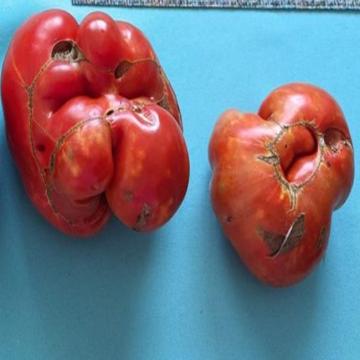Tomatoes are a beloved garden staple, but sometimes they grow in strange and deformed shapes, leaving gardeners puzzled. If you’ve ever wondered why your tomatoes don't always come out perfectly round and smooth, you’re not alone. Here’s a guide to help you understand the most common reasons for deformed tomatoes and how to prevent these issues in your garden.
Catfacing
Catfacing is a condition where tomatoes develop puckered, scarred, or misshapen bottoms. It is caused by abnormal pollination, typically due to cold weather during the early stages of flower development. The name "catfacing" comes from the appearance of the deformity, which sometimes resembles a cat's face.
Prevention:
- Plant your tomatoes after the last frost date in your area to avoid cold temperatures during flowering.
- Use floating row covers to protect plants from unexpected cold snaps.
Zippering
Zippering is a condition where tomatoes develop a thin, vertical scar that resembles a zipper. This occurs when the anther (the pollen-producing part of the flower) sticks to the young fruit, causing a scar as the tomato grows.
Prevention:
- Choose tomato varieties that are less prone to zippering.
- Ensure proper pollination by gently shaking the plants to encourage the release of pollen.
Environmental Stress
Tomatoes are sensitive to changes in temperature, humidity, and moisture. Extreme weather conditions, such as excessive heat or drought, can cause irregularities in fruit development, leading to misshapen or cracked tomatoes.
Prevention:
- Water your tomatoes consistently, aiming to keep the soil evenly moist.
- Mulch to regulate soil temperature and retain moisture.
- Protect your plants from extreme heat by using shade cloths during the hottest part of the day.
Pest and Disease Damage
Pests such as stink bugs, aphids, and thrips can damage developing tomatoes by feeding on them, causing deformities. Additionally, diseases like viral infections can also lead to abnormal fruit shapes.
Prevention:
- Regularly inspect your plants for pests and use organic or chemical controls as needed.
- Keep your garden clean and free of debris to reduce the chances of disease.
- Rotate crops annually to prevent the buildup of pests and diseases in the soil.
Nutrient Imbalances
Tomatoes require a balance of nutrients for proper growth. A deficiency or excess of certain nutrients can result in deformed fruit. For example, an excess of nitrogen can lead to excessive foliage growth at the expense of fruit quality, while a deficiency in potassium may cause uneven ripening and poor fruit formation.
Prevention:
- Use a balanced fertilizer formulated for tomatoes, and follow the recommended application rates.
- Conduct a soil test to ensure your garden soil has the right nutrient balance.
- Avoid over-fertilizing, especially with nitrogen-heavy fertilizers.
Genetics and Varieties
Sometimes, deformed tomatoes are simply a result of the variety you’re growing. Heirloom tomatoes, while prized for their flavor and uniqueness, are often more susceptible to deformities than modern hybrid varieties bred for uniformity.
Prevention:
- If you prefer perfect-looking tomatoes, choose hybrid varieties known for producing uniform fruit.
- Accept that some heirloom varieties may have a more natural, less-than-perfect appearance, but they make up for it with incredible flavor.
Conclusion
While deformed tomatoes can be frustrating, they are usually still edible and tasty. Understanding the causes of these deformities can help you take steps to prevent them in the future. By providing consistent care, addressing environmental stressors, and selecting the right tomato varieties, you can improve the quality and appearance of your tomato harvest. Even if a few of your tomatoes are less than picture-perfect, they’re still a rewarding part of the gardening experience.

